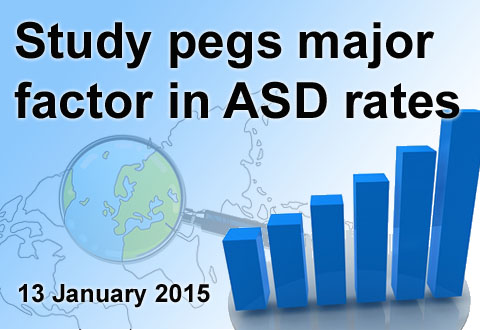Archives
January, 2015
Select a different month in the archive
Tiny Air Pollutants During Pregnancy Increase ASD Risk
By Shana R. Spindler, PhD on January 30, 2015

Background: While genetic factors play a significant role in Autism Spectrum Disorder (ASD), several studies have pointed to air pollution as a potential environmental contributor to ASD risk.
What’s new: On December 18, 2014, the journal Environmental Health Perspectives featured a study exploring the correlation between ASD and air pollutant exposure before, during, and after pregnancy. The researchers found that exposure to particulate matter less than 2.5 micrometers in size—about 1/30 the width of a hair—during the third trimester significantly associated with an increased risk of autism. Larger particulate matter (2.5-10 micrometers) and exposure before pregnancy, during the first and second trimesters, and after pregnancy were not strongly linked to autism.
Why it’s important: Three recent studies found similar results. The strengths of the current study include a relatively large sample size (245 cases and 1522 controls), sampling from across the United States, timing of pollutant exposure, and a focus on specific particulate matter. The type of air pollution associated with ASD risk in this study is produced by all types of combustion, including car engines, power plants, and wood burning.
Help me understand :
| Source(s) : |
| Tweet |
Brief Observations Unreliable for ASD Diagnosis
By Chelsea E. Toledo, M.A. on January 22, 2015

Background: Although studies have identified differences in children with autism spectrum disorder (ASD) appearing as early as infancy, the behavior of very young children with ASD could match that of typically developing counterparts at times. With age, atypical behaviors appear with increasing frequency in children with ASD. This pattern is potentially problematic for families seeking early diagnosis, as the behavioral observations considered in clinicians’evaluations of children are usually quite brief.
What’s new: The February 2015 issue of Pediatrics included a study exploring the efficacy of brief behavioral observations for identifying children with ASD. The researchers conducted evaluations for a total of 44 children between the ages of 15 and 33 months, administering multiple questionnaires and observations to assign them to one of three groups: ASD, language delay, and typical development. Two psychologists specializing in early childhood development then watched 10- to 30- minute videos of the children to make their own evaluations. The researchers found that the experts were unable to catch 39 percent of the ASD cases from the brief observations alone, as the children with ASD demonstrated typical behavior 89 percent of the time.
Why it’s important: This is the first study to measure the extent to which young children with ASD can exhibit typical behavior. It suggests that any atypical behaviors appearing in observations merit follow-up and additional screening.
Help me understand :
| Source(s) : |
| Tweet |
Autism Increase Attributed to Reporting Practices
By Chelsea E. Toledo, M.A. on January 13, 2015

Background: The United States Centers for Disease Control and Prevention estimates that 1 in 68 American children will receive a diagnosis of autism spectrum disorder, or ASD. The rate has increased significantly since autism first appeared in the Diagnostic and Statistical Manual of Mental Disorders in 1980.
What’s new: The January issue of JAMA Pediatrics featured a study examining autism prevalence in Denmark, where rates of ASD have also increased. Because of the country’s nationalized health system, the researchers were able to examine the records of all 677,915 Danish children born between 1980 and 1991, following up until 2011. They determined that two-thirds of the increase in ASD rates could be attributed to changes in the diagnostic criteria in 1994 and the inclusion of diagnoses from outpatient facilities in 1995.
Why it’s important: This is the first large-scale study to quantify the effect changes in reporting practices have on ASD rates. Future research could determine the cause of the increase not explained by changes in reporting practices, as well as the generalizability of these findings to other countries, such as the United States.
Help me understand :
| Source(s) : |
| Tweet |

